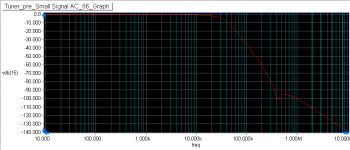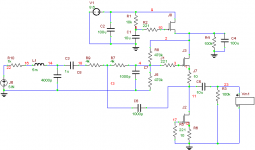Hitsware, this is a toy in a plastic box. 2 prong only.
maybe put it in a metal box and add
a 3 pronged mains plug w/green to the
case .................
or not 🙂
maybe put it in a metal box and add
a 3 pronged mains plug w/green to the
case .................
or not 🙂
He should be thankful it only has a two prong plug. The AC safety ground, other than providing safety, serves no other purpose but to cause noise and host of other problems.
se
He should be thankful it only has a two prong plug. The AC safety ground, other than providing safety, serves no other purpose but to cause noise and host of other problems.
se
Normally I would wholly agree,
But in this case ..... (or lack of)
????
Normally I would wholly agree,
But in this case ..... (or lack of)
????
What's different in this case?
se
The case is probably OK, and hopefully RF shielded. Usually they put something conductive on the plastic. The REAL problem, at least to me, is the rather wide band of noise that is so extended. It just doesn't look right, and I think that attenuating it above 50KHz or so would be a good thing to keep it from affecting the preamp or power amp in a negative way.
The case is probably OK, and hopefully RF shielded. Usually they put something conductive on the plastic. The REAL problem, at least to me, is the rather wide band of noise that is so extended. It just doesn't look right, and I think that attenuating it above 50KHz or so would be a good thing to keep it from affecting the preamp or power amp in a negative way.
John,
Can you post a plot of the noise?
>What's different in this case?
We usually associate 3 prong problems with mains noise,
but here we have digital hash.
We usually associate 3 prong problems with mains noise,
but here we have digital hash.
>What's different in this case?
We usually associate 3 prong problems with mains noise,
but here we have digital hash.
Which a 3 prong plug will do nothing for and just makes things worse.
se
There is a previous link on this thread that has all the measurements, and applies their own approach to the filter. My alternative would be to use a jfet follower instead, and perhaps a 3 or more pole filter to remove the RFI.
There is a previous link on this thread that has all the measurements, and applies their own approach to the filter. My alternative would be to use a jfet follower instead, and perhaps a 3 or more pole filter to remove the RFI.
Gee, try a small coil 10-15 turns 1/8" diameter and a small cap say 47 pf silver mica before the buffer and maybe if really bad a smaller coil and larger cap on the output. Coils here are not the same as trying to make a power amp stable.
I agree, however a 2-3 pole active filter is easy to make as well. I do think that a air coil is optimum, as you have described right at the digital audio output.
I agree, however a 2-3 pole active filter is easy to make as well. I do think that a air coil is optimum, as you have described right at the digital audio output.
An active filter really doesn't work right when the active devices run out of bandwidth.
My buffer has 8Mhz bandwidth simmed in Spice.
With filter, inductor and cap before Sallen Key: -3dB at 28kHz, -40dB at just over 100kHz.
Works pretty good ... by my standards 🙂
John
With filter, inductor and cap before Sallen Key: -3dB at 28kHz, -40dB at just over 100kHz.
Works pretty good ... by my standards 🙂
John
An active filter really doesn't work right when the active devices run out of bandwidth.
Well said, Simon. With usual opamps, slew rate about 20V/us, amplitude frequency plot turns up somewhere at 15MHz.
I agree, but what would you estimate the gain bandwidth of fet follower to be? That is why I am thinking of choosing it, instead of an IC.
Well said, Simon. With usual opamps, slew rate about 20V/us, amplitude frequency plot turns up somewhere at 15MHz.
I tried out to 20MHz and didn't see a turn up, but maybe in the real world that is different?
Is 15MHz really going to be a concern any way. The noise drops off a whole lot even at 5MHz with the standard unit.
An active filter really doesn't work right when the active devices run out of bandwidth.
Thanks for bringing that up Simon. I hadn't thought about that.
I agree, but what would you estimate the gain bandwidth of fet follower to be? That is why I am thinking of choosing it, instead of an IC.
John, are you asking me or Simon? The GBW of my buffer is 8Mhz using a BF862. When you say a FET follower did you mean a circuit with gain? I thought you meant JFET buffer. I don't know if a buffer will have enough gain in our system ... it will be close I think.
But, I can always adjust the gain of our preamp, which doesn't have much right now.
Here's the circuit I simmed:
Attachments
- Status
- Not open for further replies.
- Home
- Member Areas
- The Lounge
- John Curl's Blowtorch preamplifier part II

